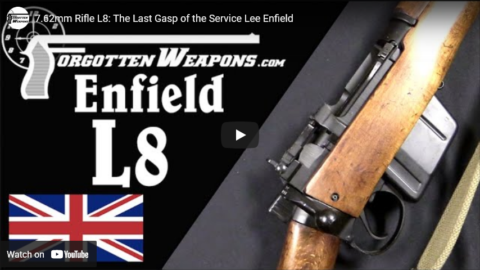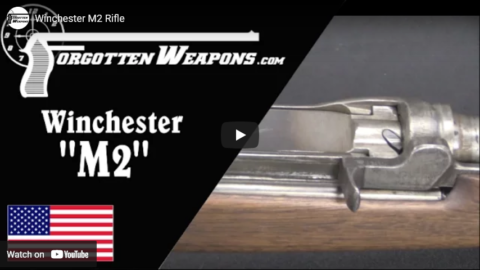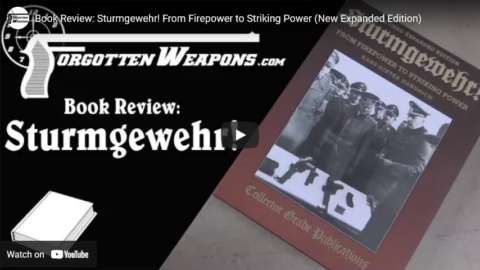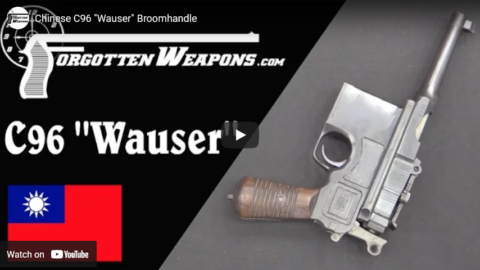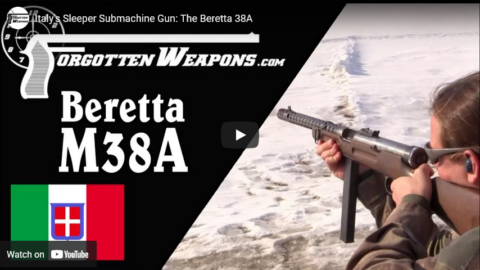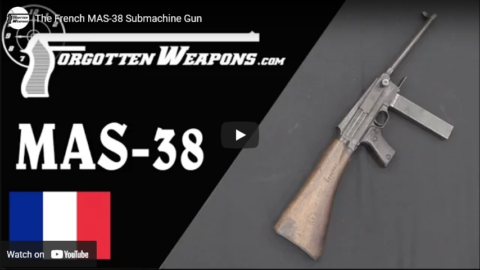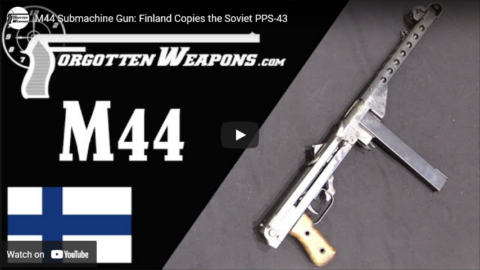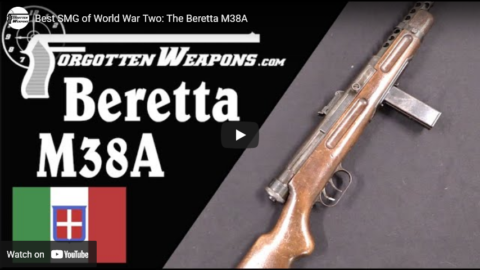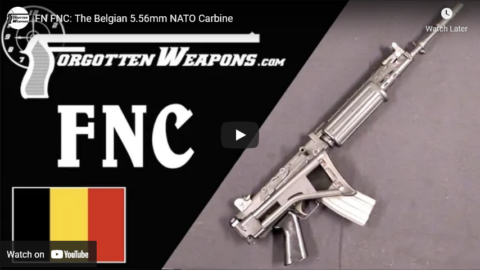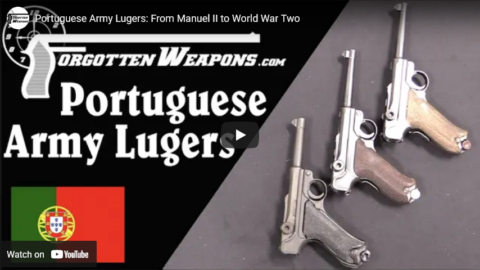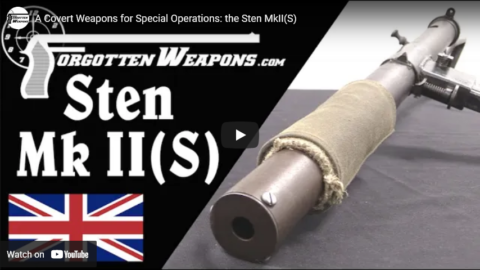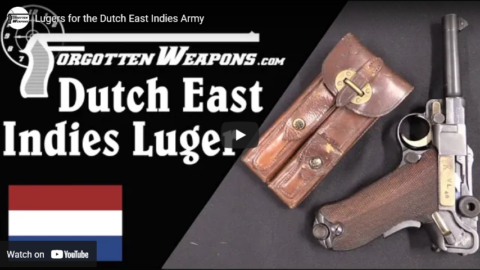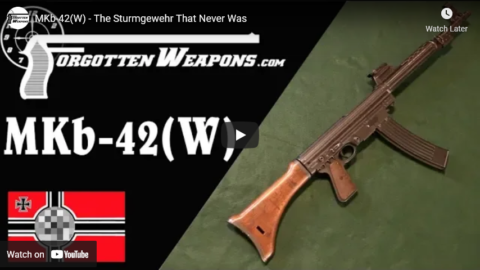Forgotten Weapons
Published 13 Dec 2021http://www.patreon.com/ForgottenWeapons
https://www.floatplane.com/channel/Fo…
Cool Forgotten Weapons merch! http://shop.forgottenweapons.com
After the British adopted the FAL as the L1A1 rifle, there was still an interest in converting stocks of existing No4 Enfield rifles to the new 7.62x51mm cartridge for reserve and training use. A conversion system was developed using a new barrel, bolt, and magazine — although the Sterling company was doing much the same thing at the same time and intellectual property lawsuits would close the project for nearly 10 years. By the time the lawsuits cleared up, it had become clear that the rifles were neither particularly successful nor particularly necessary anymore. The problem the British has was one of accuracy — the 7.62mm version just wasn’t sufficiently accurate. A thousand were sold to Sierra Leone, and a few more used in New Zealand and by cadet organizations in the UK, but the project was basically a failure.
Contact:
Forgotten Weapons
6281 N. Oracle 36270
Tucson, AZ 85740
April 18, 2022
7.62mm Rifle L8: The Last Gasp of the Service Lee Enfield
April 14, 2022
Winchester M2 Rifle
Forgotten Weapons
Published 29 Jul 2016http://www.patreon.com/ForgottenWeapons
In the previous video, we looked at the Winchester G30M rifle as it was submitted to Marine Corps trials in 1940. When the trial result came back with the G30M in last place, Winchester immediately assigned David Williams to work on adapting it to resolve the problems found in testing. What Williams did was to replace the tilting bolt with a virtual duplicate of the Garand’s two-lug rotating bolt. Williams also worked to reduce the weight of the gun, and was able to bring it down to a remarkable 7.5 pounds (3.4kg).
This prototype of the rifle (which Winchester optimistically designated the M2, implying that it would supercede the M1 Garand) was actually made largely from M1 Garand forgings, as Winchester was by this time building M1 rifles on contract. The receiver, bolt, and operating rod in this rifle was converted from Garand parts. Clearly it is not a finished product, and shows many signs of being a shop prototype — but it was in this state when it was shown to Rene Studler of the Ordnance Department in early 1941. Studler was impressed by the design, but knew that it would not replace the M1 at that point. However, he urged Winchester to scale the gun down to the .30 Carbine cartridge (which Winchester had themselves developed) and submit it in the second round of the Light Rifle testing which was to happen soon.
Does a two-lug rotating bolt, short stroke gas tappet, and Garand-style operating rod sound like a familiar set of features? Well, there is good reason … Winchester took Studler’s advice, and the scaled-down version was developed in just a few weeks and proved to be the best gun in the trials. It would be developed quickly into the M1 Carbine, and become the most-manufactured semiauto rifle of WWII.
At that point Winchester would set aside the .30-06 side of this rifle design for a little while, as they had plenty of work now with M1 Garand and M1 Carbine production. But we will see the M2/G30M/G30 come back in new form in the next episode …
April 11, 2022
Book Review: Sturmgewehr! From Firepower to Striking Power (New Expanded Edition)
Forgotten Weapons
Published 17 Sep 2017Get your copy from Collector Grade Publications: http://www.collectorgrade.com/bookshe…
Collector Grade is known for being a premiere publisher of technical firearms reference books, and I would be willing to argue that Sturmgewehr! by Hans-Dieter Handrich is the best book they have yet printed. The book was originally printed in 2004, and by the time I started looking for a copy myself, it was out of print and the price had jumped to at least $250, when I could even find a copy. I could never quite bring myself to pay that much, and so I was very excited when I learned that an expanded second edition was in the works. Well, that second edition is available now, and it’s even better than I had anticipated.
What makes Sturmgewehr! such an excellent book in my opinion is how it tackles the story of the MP43/MP44/StG44 from several different angles in depth. It has the mechanical development of the gun from prewar experiments to the open-bolt MKb-42 trials guns to the production versions. But it also puts those guns in historical context, how they related to the other weapons being used by both Germany and other nations. It discusses how the design criteria of the Sturmgewehr were arrived at, in terms of logistics and manufacturing methodologies. It explains in detail the political disagreements and convoluted process of weapon design and adoption in Germany, including the three direct rejections of the concept by Hitler.
In short, it gives you the fully-rounded story of how the German military conceived and implemented a whole new class of small arms. In this way, it is really much more than just a book about a single gun’s history — what you learn reading Handrich’s work will give you insight into virtually all arms design programs of the 20th century, from the Chauchat to the 7.62mm NATO rifle trials to the SA80.
If you already have a copy of the original work, you will probably want this one as well, to get the additional 120 pages of information that have been added. And it should go without saying that if you don’t have the original, you should absolutely get a copy of this new edition before it also falls out of print!
http://www.patreon.com/ForgottenWeapons
Cool Forgotten Weapons merchandise! http://shop.bbtv.com/collections/forg…
If you enjoy Forgotten Weapons, check out its sister channel, InRangeTV! http://www.youtube.com/InRangeTVShow
April 8, 2022
Chinese C96 “Wauser” Broomhandle
Forgotten Weapons
Published 10 Nov 2016Cool Forgotten Weapons Merch! http://shop.bbtv.com/collections/forg…
The C96 Mauser was a very popular handgun in China in the 1920s and 30s, which naturally led to a substantial number of domestically-produced copies of it. These ran the full range of quality, from dangerous to excellent. This particular example falls into the middle, appearing to be a pretty fair mechanical copy of the C96 action. However, it does exhibit classic Chinese misspelled markings — the workers who made these guns often did not actually read English (or German), and made best-guess attempts at copying the markings on authentic firearms. The result was sometimes something like the Wauser.
April 2, 2022
Afghan Traditional Jezail
Forgotten Weapons
Published 1 Feb 2017The Jezail is the traditional rifle of the Afghan tribal fighter, although it originated in Persia (Iran). Distinctive primarily for its uniquely curved style of buttstock, these rifles still maintain a symbolic importance although they are utterly obsolete.
Every jezail is a unique handmade weapon, but they all share some basic traits. They are typically built around complete lock assemblies, from captured guns or bought/traded parts. The barrel is typically quite long and rifled, and the caliber is generally .50 to .75 inch. Unlike the domestic American flintlock long rifles, the jezail is meant for war and not hunting.
http://www.patreon.com/ForgottenWeapons
Cool Forgotten Weapons merch! http://shop.bbtv.com/collections/forg…
If you enjoy Forgotten Weapons, check out its sister channel, InRangeTV! http://www.youtube.com/InRangeTVShow
March 30, 2022
Italy’s Sleeper Submachine Gun: The Beretta 38A
Forgotten Weapons
Published 16 Mar 2018The Beretta 38A is not a gun that comes to mind for many people today when discussing World War Two submachine guns, but at the time it was one of the most desirable guns of its type. So — does it live up to that reputation?
http://www.patreon.com/ForgottenWeapons
Cool Forgotten Weapons merch! http://shop.bbtv.com/collections/forg…
If you enjoy Forgotten Weapons, check out its sister channel, InRangeTV! http://www.youtube.com/InRangeTVShow
March 27, 2022
Book Review: The Uzi Submachine Gun Examined, by David Gaboury
Forgotten Weapons
Published 13 Aug 2017The UZI Submachine Gun: Examined is a newly published book this year by David Gaboury — long time owner and operator of the uzitalk.com forum. Until now there has not really been any substantive written reference material on the Uzi, but Gaboury has certainly changed that!
The Uzi has not really seen many major variations in its design beyond the Uzi/Mini Uzi/Micro Uzi scaling (and the semiauto and full auto variations of each), but it has lived two rather distinct lives. One is the Uzi as a global military arm, and the other is the Uzi as an American commercial product — and this book covers both in excellent detail.
On the military side, the book begins with a substantial chapter on the initial development of the Uzi and Israeli submachine gun trials. A remarkably wide variety of guns were considered by the Israeli armed forces, and the trial ultimately came down to two domestic designs. The influence of the Czech ZK-476 and SA vz 23/4/5/6 designs are well explained, and much of the mythology about where the design came from is dispelled. Gaboury makes good use of both original documentary sources and firsthand conversation with those who were involved at the time to tell this story.
With the gun accepted, in production, and becoming very popular with Israeli troops, international sales become a possibility. Gaboury covers the adoption of the gun by the Dutch armed forces, followed by the German and South African militaries — as well as the licensed production by FN. He also examines other copies and adaptations, including Croatian, Japanese, and Chinese.
The second half of the Uzi story is that of its sale in the United States (including the use by US security organizations including the Secret Service). This is a story every bit as complex and detailed as the international military use of the gun, as US legal changes in 1968, 1986, 1989, 1994, and 2004 all play a major role in dictating changes that must be made to the guns for import and sale. In particular, Gaboury has detailed chapters on the major sellers of Uzis in the US — Action Arms, Group Industries, and Vector Arms (as well as many other smaller players).
While there may not be many major variations of the Uzi, there are a multitude of smaller changes to individual parts in both design and production technique, and Gaboury covers these in remarkable detail. If there is a flaw to the book, it is not in lack of detail, but perhaps in a bit of dryness to the writing. The information is clearly presented, but not particularly engaging to the reader who is only mildly interested in the subject. This is a minor criticism, however, and the book is an outstanding reference for anyone who has, well, really any questions at all about the Uzi.
http://www.patreon.com/ForgottenWeapons
Cool Forgotten Weapons merchandise! http://shop.bbtv.com/collections/forg…
If you enjoy Forgotten Weapons, check out its sister channel, InRangeTV! http://www.youtube.com/InRangeTVShow
March 24, 2022
The French MAS-38 Submachine Gun
Forgotten Weapons
Published 4 May 2017The MAS-38 was France’s first officially adopted submachine gun, rushed into service in 1940. It was basically too late to help with the defense of France, with less than a thousand delivered by June 1940. The Germans kept the gun in production, making 20-30 thousand under the designation MP722(f). French production picked up immediately after the war, and 203,000 were made by the end of 1951. The gun would see service mostly in Indochina.
Mechanically, the MAS 38 is a simple blowback SMG, although it has a few unusual features. One is the approximately 6 degree angle between the barrel and receiver, which was done in order to drop the stock and allow a sight picture with shorter iron sights. As a result, the bolt face is also cut at about a 6 degree angle off perpendicular. The safety is the trigger itself, which folds up and forward to engage, locking the bolt in place. The weapon is chambered for the 7.65 French Long cartridge, which was also used in the 1935A and 1935S pistols. It is lighter than most other military submachine gun rounds, roughly on par with 9x18mm Makarov. That reduced ballistic peer does make for a very comfortable and controllable weapon, however.
http://www.patreon.com/ForgottenWeapons
Cool Forgotten Weapons merch! http://shop.bbtv.com/collections/forg…
If you enjoy Forgotten Weapons, check out its sister channel, InRangeTV! http://www.youtube.com/InRangeTVShow
March 21, 2022
M44 Submachine Gun: Finland Copies the Soviet PPS-43
Forgotten Weapons
Published 17 Nov 2021http://www.patreon.com/ForgottenWeapons
https://www.floatplane.com/channel/Fo…
Cool Forgotten Weapons merch! http://shop.forgottenweapons.com
The kp/31 Suomi submachine gun in Finnish service was an outstanding weapon, but it was slow and expensive to manufacture. When Finnish forces began capturing Soviet PPS-42 and PPS-43 submachine guns from the Soviets in the Continuation War, it was very quickly decided that Finland should copy the design. This was a far simpler, far cheaper stamped sheet-metal design that was not as refined as the Suomi, but much more efficient to make.
The Sudayev design was changed only minimally; primarily to fit the Finnish cartridge (9x19mm Parabellum) and magazines. The guns were originally designed to use the 50-round quad-stack boxes and 71/72 round drums of the Suomi, but also used the Swedish Carl Gustaf m/45 magazine that was adopted by Finland after WW2.
Two companies were approached to produce the M44; Tikkakoski and Ammus Oy. Ammus was unable to source raw materials for the project, and only Tikka put the guns into production. Marshal Mannerheim initially wanted 50,000, but the order was reduced to 20,000 — of which only 10,000 were actually made, due to limited material availability before the end of the war led to production ending. Another 400 were assembled from remaining parts after the war.
In the 1950s, a plan was begun to resume M44 production in order to completely replace the Suomi in Finnish inventory. However, this plan was interrupted when Sam Cummings of InterArms made a deal to trade Finland about 75,000 surplus Sten guns for Finland’s supply of 7.35mm Carcano rifle (received as aid from Italy during the war) along with a melange of old machine guns. This was a sufficient quantity of Stens to handle the duties of the Suomi, and so the Sten went into Finnish service and M44 production was never resumed.
Those Carcano rifles were in turn imported into the United States, and this is why the majority of 7.35mm Carcano here bear Finnish “SA” property stamps. The same is true for the significant number of Chauchat automatic rifles in the US with Finnish property marks, which were also part of the deal.
Contact:
Forgotten Weapons
6281 N. Oracle 36270
Tucson, AZ 85740
March 18, 2022
Best SMG of World War Two: The Beretta M38A
Forgotten Weapons
Published 15 Nov 2021http://www.patreon.com/ForgottenWeapons
https://www.floatplane.com/channel/Fo…
Cool Forgotten Weapons merch! http://shop.forgottenweapons.com
The Beretta Model 38A was one of the very best submachine guns of World War Two. Designed by veteran Beretta engineer Tullio Marengoni (who designed most of Beretta’s pistols as well as the Beretta M1918 SMG and 1918/30 carbine), it was the first Italian weapon to use a cartridge equivalent to 9x19mm Parabellum instead of 9mm Glisenti. Development began in 1935, and the final version entered production in January 1938.
The change from the Model 38 to 38A is unclear, but seem most likely to be the change from the top ejection of the prototypes to the left-side ejection of the production model. The 38A was formally adopted by the Italian Army in July 1938, but issue was delayed until 1940/41 because Beretta first produced a 20,000-unit order for the Romanian military.
By 1941, the basic design had been significantly simplified, and the Model 38/42 would significantly reduce production cost by removing the magazine well cover, barrel shroud, and removable firing pin. Simplified 38/42, 38/43, and 38/44 models would enter production, but original 38As were also manufactured until 1944 (this particular example is dated 1943). The gun was very popular with both Italian and German troops, and production continued under German occupation late in the war. Total numbers are unavailable, but are probably in excess of 500,000. The gun was so popular that Beretta was able to restart production after the war and continue selling them until the early 1960s.
Contact:
Forgotten Weapons
6281 N. Oracle 36270
Tucson, AZ 85740
March 15, 2022
FN FNC: The Belgian 5.56mm NATO Carbine
Forgotten Weapons
Published 12 Nov 2021http://www.patreon.com/ForgottenWeapons
https://www.floatplane.com/channel/Fo…
Cool Forgotten Weapons merch! http://shop.forgottenweapons.com
The FNC (Fabrique Nationale Carabine) was FN’s followup to the unsuccessful CAL rifle. Chambered for the newly-adopted 5.56mm NATO cartridge, the FNC uses a long stroke gas piston system very reminiscent of the AK, combined with a stamped upper and milled aluminum lower. After about 5 years of development, the FNC was put on the market in 1980, and was quickly purchased by Indonesia, along with a license for domestic production as the Pindad SS-1. It would also be adopted by Sweden as the AK-5 (minus the 3-round burst functionality) and Belgium. About 6,000 semiautomatic sporting models were imported into the US. A number of those, including this one, were legally registered as transferrable machine guns before 1986.
Contact:
Forgotten Weapons
6281 N. Oracle 36270
Tucson, AZ 85740
March 12, 2022
Portuguese Army Lugers: From Manuel II to World War Two
Forgotten Weapons
Published 10 Nov 2021http://www.patreon.com/ForgottenWeapons
https://www.floatplane.com/channel/Fo…
Cool Forgotten Weapons merch! http://shop.forgottenweapons.com
Portugal first tested the Luger pistol in 1901, and its commission on self-loading pistols recommended the design for adoption in 1904. No money was available at the time, but a second commission again recommended the Luger in 1907, and it was formally adopted and purchased in 1908. The initial batch was 5,000 pistols chambered for the 7.65mm Parabellum cartridge with 120mm (4.75″) barrels and “M2” crests for then-king Manuel II. They were designated m/908, and numbered from 1 to 5000.
These pistol would satisfy Portuguese Army needs until 1935, then the Guarda National Republicana ordered another 564 pistols in the same configuration. These came from Mauser at this point, and had “GNR” crests. These were taken from Mauser commercial production, and have serial numbers between 1900v and 2500v.
The final purchase of Portuguese Army Lugers came in 1943, another 4,578 guns from Mauser. Of course, Germany was deep into the Second World War by this time, and there was no option for Portugal to order its specific configuration. Instead, the Portuguese m/943 pattern was identical to the German standard P08, with the Portuguese guns coming right off the same production line — Waffenamt markings and all. They are numbered between 150m and 5330m.
Contact:
Forgotten Weapons
6281 N. Oracle 36270
Tucson, AZ 85740
March 9, 2022
A Covert Weapons for Special Operations: the Sten MkII(S)
Forgotten Weapons
Published 5 Nov 2021http://www.patreon.com/ForgottenWeapons
https://www.floatplane.com/channel/Fo…
Cool Forgotten Weapons merch! http://shop.forgottenweapons.com
There are a fairly wide variety of silenced Sten guns that were made during World War Two, because many were needed for small Special Operations Executive missions. However, the British Army did also formally develop and adopt such a weapon. It was initially requested in 1942, with the first trials in November of that year. After two years of tinkering and deliberating, a pattern was finally put into production in February 1944. This was a Sten MkII with an integrally suppressed barrel. The barrel was just 3.75 inches long, with six vent holes drilled just in front of the chamber to reduce muzzle velocity below the speed of sound. The silencer itself was about 12 inches long, with an initial expansion chamber and 18 baffles.
Since the vented barrel reduced recoil energy of the cartridge, the bolt was reduced in weight by about 15% and the recoil spring shortened just slightly as well, to ensure proper cycling. The result was formally designated the Sten MkII(S). It retained the selective fire capability of the Sten, but was not to be used in automatic mode, as doing so could compress the baffles together and damage them. In total, 5,776 of these silent submachine guns were made. The design was followed by a more sophisticated Sten Mk6 (essentially a silenced Mk5), but remained in active use with the British military into the early 1970s.
Finding completely original and intact examples of the MkII(S) is extremely difficult today, and this one is a rare privilege to examine!
Contact:
Forgotten Weapons
6281 N. Oracle 36270
Tucson, AZ 85740
March 6, 2022
Lugers for the Dutch East Indies Army
Forgotten Weapons
Published 3 Nov 2021http://www.patreon.com/ForgottenWeapons
https://www.floatplane.com/channel/Fo…
Cool Forgotten Weapons merch! http://shop.forgottenweapons.com
Note: When I say the double magazine pouch is unique for this model, I was not thinking about those issued with LP-08 Artillery Lugers.
While the Dutch Army dithered over new pistol adoption, the Dutch East Indies Army (KNIL) took more decisive action and adopted the Luger as the M11 in 1911 after a few years of testing. They ordered the first batch of 4,181 from DWM in the years before World War One. After the Treaty of Versailles, German companies were barred from military production, and so the KNIL bought a batch of 6,000 Lugers from the Vickers company in the UK. These were still insufficient for the force, and in 1928 they ordered one final batch of guns.
This final batch was made by DWM. The Allied Control Commission ceased operation in 1927 and left Germany, and DWM almost immediately resumer Luger production. This final batch consisted of 3,828 more M11 pattern pistols. All three batches were in a single serial number range, starting at 1 and running to 14020. They were chambered for the 9x19mm Parabellum cartridge, with 4 inch (100mm) barrels. Unit marks were engraved originally on the back of the frame, but in 1919 this was replaced with the use of a small brass plaque on the trigger guard. A plaque on the left side of the frame was introduced for unit marks in 1939, as seen on this example.
We also have an original KNIL M11 holster and double magazine pouch to take a look at — accessories that are extremely rare today.
Contact:
Forgotten Weapons
6281 N. Oracle 36270
Tucson, AZ 85740
March 3, 2022
MKb-42(W) – The Sturmgewehr That Never Was
Forgotten Weapons
Published 6 Jul 2018http://www.patreon.com/ForgottenWeapons
Cool Forgotten Weapons merch! http://shop.bbtv.com/collections/forg…
When the German military first requested rifles in the new 8x33mm Kurz cartridge, there were two companies that provided designs. One was Haenel, who would eventually win the competition. The other was Walther, who submitted this rifle — the MKb-42(W). Where the Haenel gun fired from an open bolt and used a tilting-bolt locking system, the Walther rifle fired from a closed bolt and used a rotating bolt to lock. It also used an unusual annular gas piston. In competition, the Walther’s closed bolt operation made it more accurate in semiauto fire and less susceptible to ingress of dirt. However, it was substantially more complex and more expensive than the Haenel gun.
In total, just 200 of the MKb-42(W) were made before being cancelled in late 1942. Needless to say, very few survive today, and it was a great privilege to be able to disassemble and present this one to you. Thanks to the Association of Maltese Arms Collectors and Shooters for the invitation to do so!
If you enjoy Forgotten Weapons, check out its sister channel, InRangeTV! http://www.youtube.com/InRangeTVShow
Contact:
Forgotten Weapons
6281 N Oracle #36270
Tucson, AZ 85704

